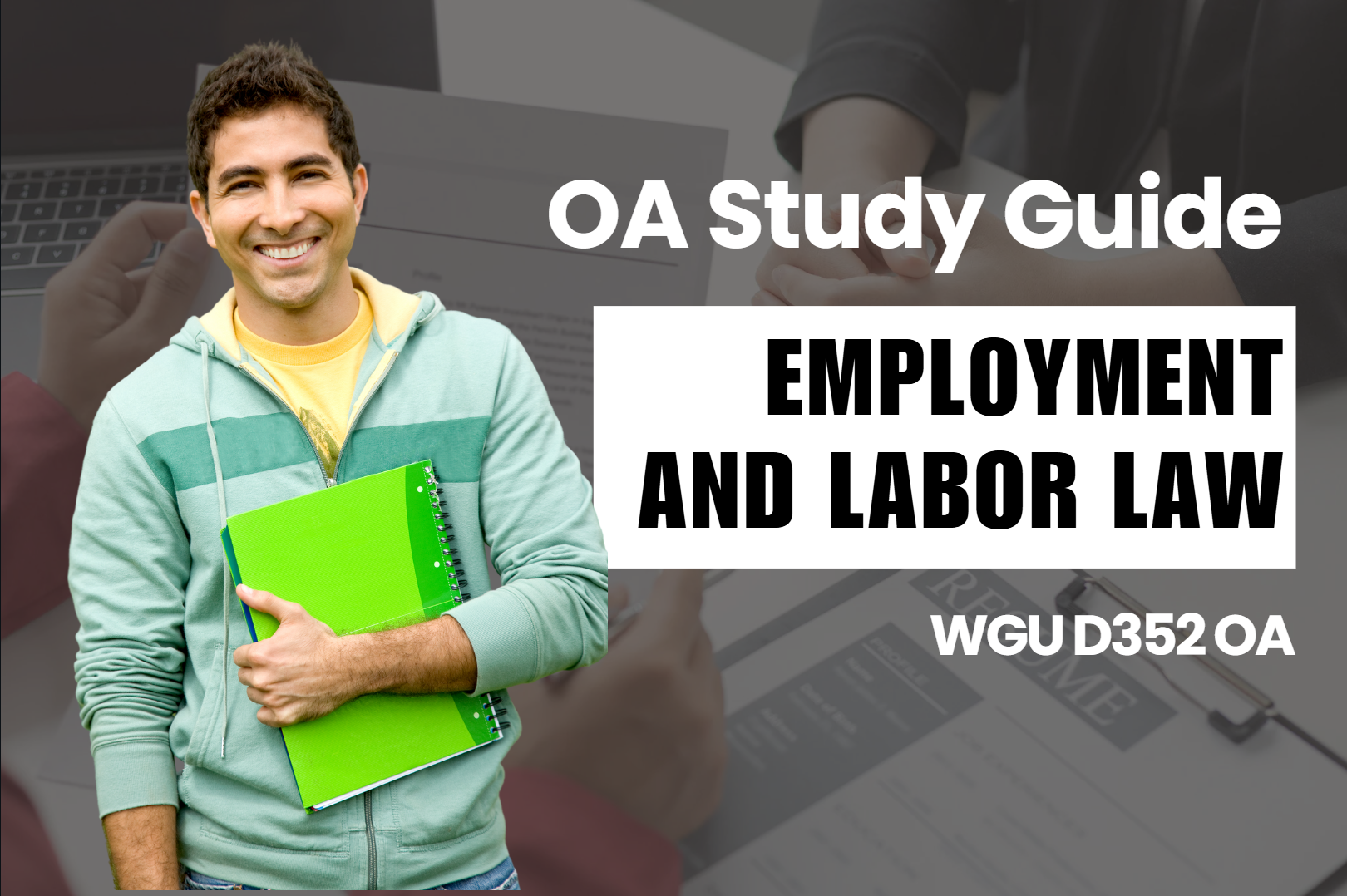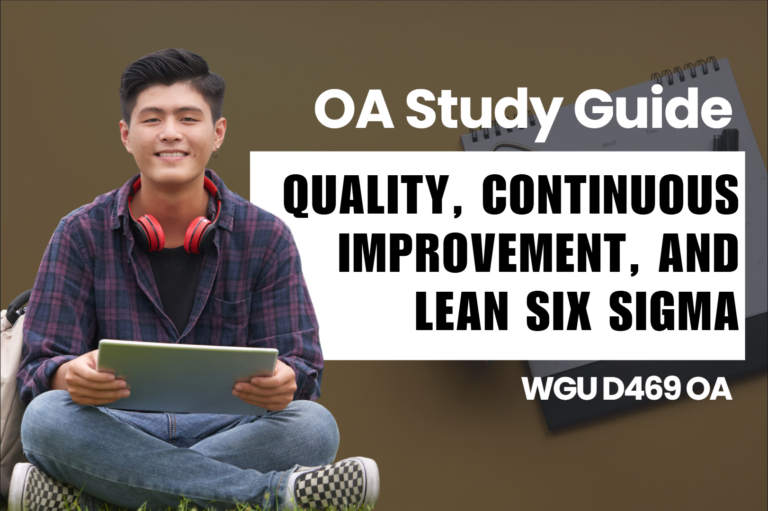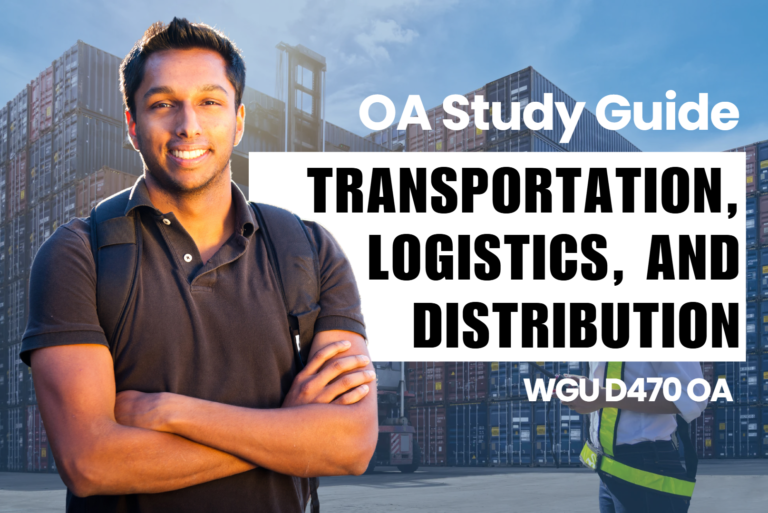WGU D352 OA Study Guide - 2025 | Mastering Employment Laws📖
Employment laws give you full protection of your workplace rights. Do you want to know how your job remains secure and the workplace runs smoothly while helping you handle unexpected life events? You’re in the right place! This guide explains the operating principles of four key workplace regulations that define work practices throughout America. These topics will be tested highly on the WGU D352 OA as well.
- Equal Employment Opportunity (EEO): EEO ensures that all employees receive fair treatment in hiring, promotion, and compensation, prohibiting discrimination based on race, gender, age, or disability.
- Americans with Disabilities Act (ADA): The ADA protects individuals with disabilities by requiring employers to provide reasonable accommodations and ensuring equal access to employment opportunities.
- Occupational Safety and Health Act (OSHA): OSHA establishes workplace safety standards, ensuring that employees work in environments free from hazards, with proper training and protections in place.
- Family and Medical Leave Act (FMLA): FMLA grants eligible employees unpaid, job-protected leave for specific family and medical reasons, such as childbirth, serious illness, or caregiving responsibilities.
When WGU D352 OA students understand these concepts they gain practical skills to protect their workplace rights. Get started with us by transforming these legal regulations into supportive tools!
How to Use This Guide for the WGU D352 OA Exam? 📝
The D352 Employment and Labor Law OA exam at WGU evaluates your understanding of employment law, workplace safety regulations, and employee rights. This guide simplifies the key concepts of Equal Employment Opportunity (EEO), the Americans with Disabilities Act (ADA), the Occupational Safety and Health Act (OSHA), and the Family and Medical Leave Act (FMLA) to help you grasp the topics tested in the exam.
We also provide exam-style questions and practical applications to ensure you’re fully prepared for the questions on the WGU D352 OA exam.

Equal Employment Opportunity (EEO): A Step-by-Step Guide For D352 OA📝
A workplace culture of equality benefits everyone who works within it and its owners. At this stage Equal Employment Opportunity (EEO) takes effect. Under EEO every person has the right to choose from available job opportunities without bias against them. We need to study this issue both plainly and completely.
What is Equal Employment Opportunity (EEO)?
Under EEO rules employers must treat everyone seeking employment and advancement equally alongside their abilities while ignoring factors of sex, race, religion, or age. Selection should depend only on a candidate’s qualifications and performance capabilities without considering personal background or preferences.
Workplaces that implement EEO principles create fair employment and boost employee engagement and job output.
The Legal Framework Behind EEO
Several laws provide the foundation for EEO in the U.S. Here are the key ones:
1. Title VII of the Civil Rights Act of 1964
Through this major legal act organizations must refrain from treating workers differently because of their racial, color, religious, sex, or ethnic backgrounds. It applies to everything it concerns with job selection and internal career progress plus all staffing choices.
2. Age Discrimination in Employment Act (ADEA)
After reaching age 40 workers have legal rights to protect them from workplace age bias. Employers should take all essential employment criteria into consideration except for workers’ age.
3. Americans with Disabilities Act (ADA)
Following ADA standards employers must allow disabled workers the same work benefits as everyone else. A company must provide job modifications to their employees until the changes prove too hard to administer.
4. Equal Pay Act of 1963
Workers must receive the same salary for doing work of identical value even though they are male or female. A company must pay its workers exactly the same amount when they do the same job with identical duties.
5. Pregnancy Discrimination Act
Under this law, businesses are banned from treating employees differently because of their pregnancy or pregnancy-related reasons. A business cannot block her from moving up in her position just because she carries a baby.
The Role of the Equal Employment Opportunity Commission (EEOC)
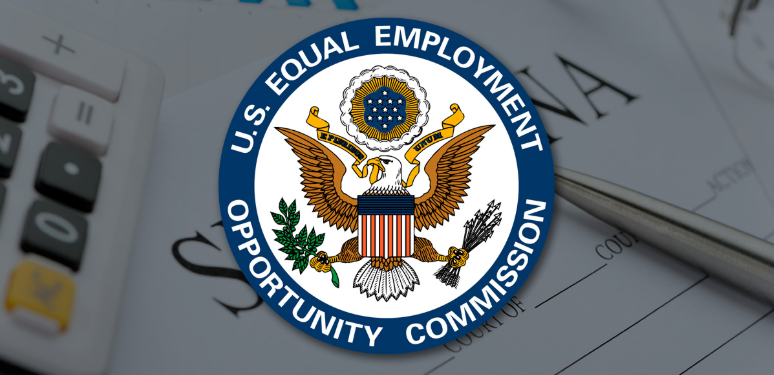
As the federal enforcement agency, the Equal Employment Opportunity Commission protects EEOC laws. They monitor companies to make sure they follow rules while looking into issues about unfair treatment of employees because of who they are. Here’s how the process works:
- Filing a Complaint: When someone at work believes they suffered employment discrimination they can start an official complaint process. Companies typically have 300 days to submit a claim after the discrimination incident takes place.
- Investigation: The workplace discrimination case becomes a target of EEOC examination before they take steps to help both parties find a solution.
- Legal Action: When needed the EEOC will initiate legal proceedings against employers.
Types of Discrimination
Determining the many ways people experience discrimination makes this knowledge essential. Let’s break them down:
Disparate Treatment vs. Disparate Impact
- Disparate Treatment: People who discriminate intentionally reject job candidates based on their racial background.
- Disparate Impact: Regulations that look fair to everyone but create uneven results for a defined group of people. A mandatory lift test would block certain workers who need access with accommodations.
Reverse Discrimination
This occurs when members of a majority group claim they are being discriminated against to favor minority groups. While less common, it’s still a valid concern under EEO laws.
Affirmative Action
Through specific actions, organizations work to help disadvantaged communities have better access to chance. These diversity initiatives must meet legal criteria to stay within allowable boundaries.
Employee Rights and Employer Responsibilities
Employee Rights:
- The right to work in an environment free from discrimination and harassment.
- The right to file complaints without facing retaliation.
- The right to reasonable accommodations for disabilities or religious practices.
Employer Responsibilities:
- Implementing anti-discrimination policies.
- Training employees and managers on EEO principles.
- Providing accommodations and addressing complaints promptly.
Americans with Disabilities Act (ADA): Empowering Equal Opportunities For D352 OA📝
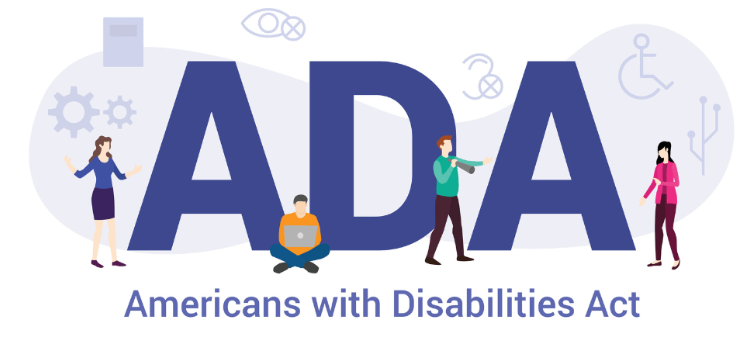
Through Americans with Disabilities Act (ADA) the United States protects disability rights enabling disabled people the same public access as others. We will examine the main features of this statute to see why it matters.
What is the Americans with Disabilities Act (ADA)?
In 1990 the US government created the ADA to protect disabled people from unfair treatment. The law makes sure everyone with disabilities can join the workforce and get fair access to community services without special barriers across different areas. Through these rules, the ADA makes sure people with disabilities have the same rights and chances to live a full life as anyone else.
Key Titles of the ADA
The ADA is divided into five sections, or “Titles,” each addressing a specific area of public life:
Title I – Employment
- Applies to employers with 15 or more employees.
- Under Title I candidates and existing workers should receive equal employment opportunities.
- Employers must make work environment changes and shift adjustments for disabled workers but they can reject these changes when doing so hurts their business operation.
Title II – Public Services
- Ensures state and local government services are accessible to individuals with disabilities.
- Covers public transportation, voting facilities, and public education.
Title III – Public Accommodations
- Official companies and charity organizations running public businesses must follow this section (such as accommodation facilities).
- These businesses must take steps to remove physical barriers from their facilities whenever possible while ensuring easy access for everyone.
Title IV – Telecommunications
- The accessibility requirements ensure telephone communications reach those who have hearing or speech disabilities using TTY devices or digital text.
Title V – Miscellaneous Provisions
- It safeguards people who use their ADA rights when they do not face workplace penalties.
- The ADA functions well with other legal frameworks, especially the Rehabilitation Act.
Who is Protected Under the ADA?
The ADA defines a disability as:
- A physical or mental impairment that substantially limits one or more major life activities.
- A record of such an impairment.
- Being regarded as having such an impairment.
Major life activities include functions like walking, seeing, hearing, learning, and working. For example, individuals with conditions such as epilepsy, diabetes, or depression are protected under the ADA.
The ADA Amendments Act of 2008 (ADAAA)
ADAAA enhanced disability classification to defend more people with disabilities. The definition of disability under this legislation must be understood in a way that brings many more people with impairments into protection.
Compliance Requirements for Employers
Employers need to act now to stay in line with ADA requirements. Key requirements include:
- Companies must adapt work arrangements for employees who need these changes because of their disability.
- Businesses need to eliminate obstacles in the workplace that stop people with disabilities from doing their jobs.
- The organization needs to create all steps of hiring that all qualified applicants can use.
Enforcement of the ADA
The Equal Employment Opportunity Commission (EEOC) upholds Title I of the ADA regulations. Here’s how the process works:
- Filing a Complaint: The EEOC deals with any complaints when people think that their ADA rights have been violated.
- Investigation: The EEOC reviews complaints and then attempts to help the employee and employer reach an agreement.
- Legal Action: When needed the EEOC takes legal action to protect individual rights under the ADA.
Tired of reading blog articles?
Let’s Watch Our Free WGU D352 Practice Questions Video Below!

Occupational Safety and Health Act (OSHA): Safeguarding Workplace Safety For D352 OA 📝
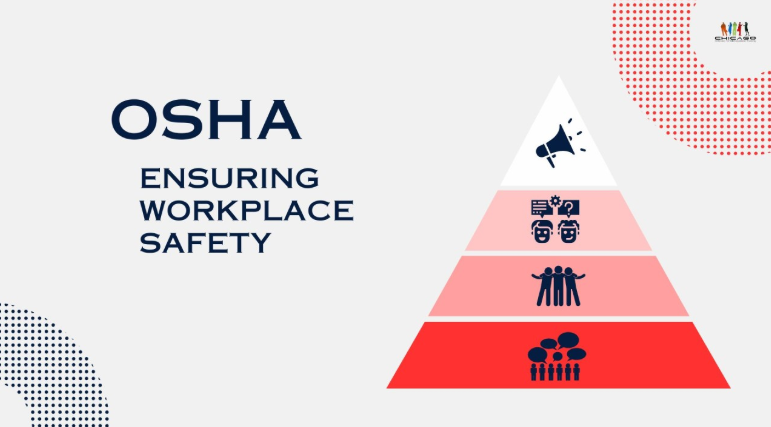
Under the Occupational Safety and Health Act (OSH Act) lawmakers created the nation’s first basic employee protection system to secure workplace safety standards for American workers. After its 1970 establishment, the OSH Act created OSHA to establish and enforce workplace safety requirements. This article looks at the key points of this important legislation one by one. Go through each key point as these will be covered on the WGU D352 OA.
Purpose and Scope of the OSH Act
The OSH Act exists to manage workplace dangers and stop occupational injuries and deaths. All private sector organizations and several public sector workplaces have to protect their employees under this law no matter their industry.
Key objectives include:
- Eliminating workplace risks such as exposure to toxic chemicals, excessive noise, and unsafe machinery.
- Setting minimum safety and health standards that employers must follow.
Establishment of OSHA
OSHA functions under the authority of the U.S. Department of Labor as a division to put the OSH Act into effect. OSHA is responsible for:
- Our team creates work safety rules and ensures everyone follows them.
- Our team regularly visits workplaces to make sure companies uphold the safety regulations.
- Safety awareness improvement comes through workplace learning sessions.
NIOSH created a specialized research department to help OSHA study the dangers at work and suggest ways to prevent them.
General Duty Clause
Under the OSH Act, the General Duty Clause plays a major part in workplace safety efforts. It states:
- Employers: Every workplace must become safe before starting work by eliminating recognized hazards that put workers at risk of fatal or serious injury.
- Employees: Workers need to follow every safety and health regulation linked to their job responsibilities.
OSHA Standards
OSHA creates clear standards to control workplace risk elements. These standards are based on extensive research and are designed to protect employees from:
- Chemical Hazards: People who work with asbestos or come into contact with lead face toxic chemical hazards.
- Physical Hazards: Workers encounter danger when noise levels spike or equipment causes harm and heat exposure.
- Biological Hazards: Bacteria and viruses spread among medical staff or scientific personnel in their workplace.
Enforcement Mechanisms
OSHA has robust enforcement tools to ensure compliance with safety standards:
- Inspections: The workplace inspection team comes unannounced to spot safety rule breaches.
- Penalties: Employers who break the rules face official monetary sanctions and legal punishments.
- Corrective Actions: The law demands employers solve problems found during inspections through necessary changes.
Employee Rights and Responsibilities
Under the OSH Act, employees have the right to:
- Work in a safe environment free from hazards.
- Receive training on workplace safety and hazard recognition.
- Report unsafe conditions without fear of retaliation.
Employees are also responsible for:
- Following safety protocols and wearing personal protective equipment (PPE).
- Reporting hazards or injuries to their employer promptly.
State Plans
States can create their own occupational safety and health programs, known as “State Plans.” These plans must be at least as effective as federal OSHA standards and are monitored by OSHA to ensure compliance.
Training and Education
Training is a cornerstone of the OSH Act’s approach to workplace safety. Employers are encouraged to provide:
- Regular safety training sessions to educate employees about risks and preventive measures.
- Updated training when new tools, technologies, or procedures are introduced.

Family and Medical Leave Act (FMLA): Supporting Work-Life Balance For D352 OA📝

Running two lives at once becomes tough when life events happen big. Under the Family and Medical Leave Act (FMLA), employees get job protection while managing their medical and family concerns. Our exploration starts with breaking down the main parts of this important law.
What is the Family and Medical Leave Act (FMLA)?
In 1993 the government created the FMLA to let eligible employees take unpaid time away from work with job protections when they need family and medical support. It protects both work stability and helps employers maintain stable incomes for their families.
Eligibility Requirements
Not every employee in an organization can take FMLA-related medical time off. To be eligible, the following criteria must be met:
- Employment Duration: For FMLA coverage the employee needs to work for this employer for at least 12 uninterrupted months. A break in service that lasts more than seven years counts for FMLA eligibility only if that separation came from military service.
- Hours Worked: Employee eligibility for leave depends on performing 1,250 hours of work during the past 12 months.
- Employer Size: Only employers with more than 50 employees within a 75-mile area of an employee’s workplace qualify.
Qualifying Reasons for FMLA Leave
Employees can take FMLA leave for the following reasons:
- Birth or Care of a Newborn: To bond with a newborn child.
- Adoption or Foster Care Placement: Workers at their workplace use leave benefits when their family welcomes adopted or fostered children.
- Care for a Family Member: Workers must use their time away from work to care for their spouse, child, or parent who needs medical care.
- Employee’s Own Health Condition: When health problems keep employees from doing their jobs they can take permitted absence from work.
- Military Exigencies: When military service creates special requirements for a family member including deployments or injuries.
Duration of Leave
Under the FMLA employees qualify for 12 weeks of unpaid leave per year for both personal and family reasons. Employees who support a covered service member with a serious injury or illness qualify for 26 weeks of leave in one year.
Job Protection and Benefits
The FMLA ensures that:
- Returning employees must find their past roles or positions offering equal pay and work benefits.
- Employers need to continue paying the employee’s health insurance when they take time off under the leave.
Requesting FMLA Leave
Employees must:
- Give us notice about your leave well before you need it but tell us at least 30 days in advance if your need is scheduled.
- Employees need to provide proper medical records or different evidence to show their need for leave.
Within five business days of receiving a leave request, the employer must tell employees about their FMLA rights and duties.
Employer Responsibilities
Under the FMLA, employers must:
- Companies must allow their workers to take Fair Medical Leave Act leave as granted by law.
- Document employee FMLA leave periods and explain to workers what they can or cannot do under the law.
- The company should never punish workers when they take their FMLA-approved time off.
Common Misconceptions
- FMLA Leave is Paid: FMLA leave is unpaid, though employees may use accrued paid leave (e.g., vacation or sick time) concurrently if allowed by their employer.
- Unlimited Leave: Employers must enforce official leave duration limits that connect personal needs to work responsibilities under the FMLA.
Tired of reading blog articles?
Let’s Watch Our Free WGU D352 Practice Questions Video Below!
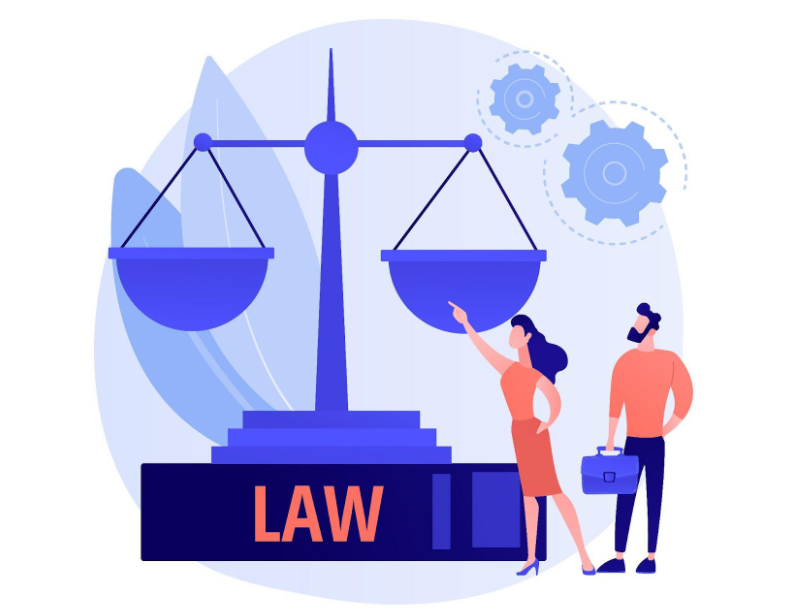
Wrapping Up: Your Path to Workplace Confidence (WGU D352📄
You have completed the entire guide so take pride in your progress. Through this guide, you have learned about the primary features of EEO, ADA, OSHA, and FMLA. These legal requirements form the fundamental elements that keep working environments both fair and secure.
For students preparing for the WGU D352 OA, these topics will play a crucial role in your final objective assessment. Make sure to understand the key principles, know how they apply in real-world scenarios, and feel confident discussing their importance. Remember, these laws aren’t just for the test—they’re practical tools for your future career.
So, take the time to review, practice, and internalize these concepts. Whether you’re an aspiring HR professional, a business leader, or just someone curious about workplace rights, this knowledge will serve you well.
Good luck on your journey through WGU D352 OA questions! You’ve got this—now go ace that module and take a step closer to mastering employment laws with confidence.


